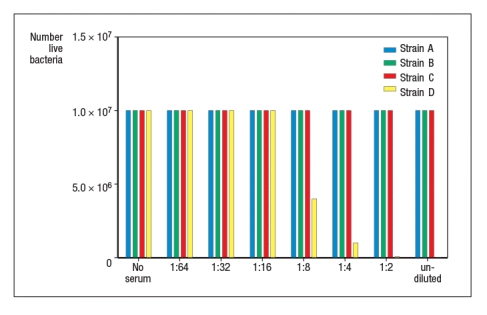Four different clinical isolates of the Gram-positive bacterium, Staphylococcus aureus, are tested for their abilities to resist innate immune defense mechanisms. For these experiments, each bacterial strain is first grown in culture to achieve log-phase replication, and then cultures are supplemented with dilutions of human serum containing normal serum proteins as well as antibodies capable of binding to S. aureus. One hour later, the cultures are analyzed and the numbers of live bacteria are quantitated. The data from this experiment are shown in Figure .
a) From these data, what general conclusions can be reached about the four strains of S. aureus?
To identify the bactericidal mechanisms killing each strain of S. aureus, the serum is depleted of complement C3 by running it over an anti-complement C3 antibody affinity column. The experiment above is then repeated and the data are shown in Figure .
b) What is the most likely mechanism accounting for the killing of strain D in this experiment?
To determine whether strains A and C are susceptible to the same microbicidal pathway, the serum is depleted of antibody by running over an anti-human immunoglobulin affinity column. Following this treatment, it is found that strain A, but not strain C is still killed by incubation with the serum.
c) From these data, what is the most likely mechanism killing S. aureus strain A? What about strain C?
Definitions:
Substandard Orphanage
A facility for orphaned children that fails to meet the basic standards of care, safety, or health.
Child's Attachment
The emotional bond that develops between a child and a caregiver, crucial for the child's personal development.
Mother's Sensitivity
A mother's ability to perceive, understand, and respond appropriately to her child's needs, emotions, and cues, fostering a secure attachment.
Secure Attachment
A strong emotional bond between a child and caregiver characterized by trust and a sense of security.
Q2: In cell culture experiments, purified B cells
Q4: Some individuals with repetitive exposure to
Q7: Blocks calcineurin-dependent activation of NFAT<br>A)Azathioprine<br>B)Cyclosporine<br>C)Mycophenolate mofetil<br>D)Rapamycin<br>E)Anti-CD40L antibody<br>F)Anti-IL-2R
Q9: CAR T cells have shown remarkable efficacy
Q13: TCR and CD28 signaling together lead to
Q25: A mouse line (called 'Wm') is
Q29: Two different vaccines have been developed that
Q55: Below is Jim Walker's income for 2013
Q76: Listed below are the top-steel producing nations,
Q82: The following table shows the average earnings